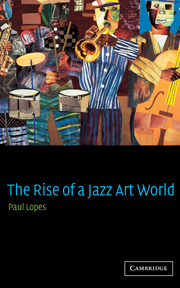Book contents
- Frontmatter
- Contents
- Acknowledgments
- Introduction: The quest for cultural legitimacy
- 1 Before the Jazz Age: professional musicians and good music
- 2 The Jazz Age: professional musicians and the cultivated vernacular
- 3 The swing craze: professional musicians, swing music, and the art of improvisation
- 4 The rise of a jazz art world: jazz enthusiasts, professional musicians, and the modernist revolt
- 5 The New Jazz Age: the jazz art world and the modern jazz renaissance
- Conclusion: The jazz art world and American culture
- Bibliography
- Index
Conclusion: The jazz art world and American culture
Published online by Cambridge University Press: 22 September 2009
- Frontmatter
- Contents
- Acknowledgments
- Introduction: The quest for cultural legitimacy
- 1 Before the Jazz Age: professional musicians and good music
- 2 The Jazz Age: professional musicians and the cultivated vernacular
- 3 The swing craze: professional musicians, swing music, and the art of improvisation
- 4 The rise of a jazz art world: jazz enthusiasts, professional musicians, and the modernist revolt
- 5 The New Jazz Age: the jazz art world and the modern jazz renaissance
- Conclusion: The jazz art world and American culture
- Bibliography
- Index
Summary
The highbrow's friend is the lowbrow. The highbrow enjoys and respects the lowbrow's art – jazz for instance – which he is likely to call a spontaneous expression of folk culture. The lowbrow is not interested, as the middlebrow is, in pre-empting any of the highbrow's function or in any way threatening to blur the lines between the serious and the frivolous … When, however, the lowbrow arts get mixed up with middlebrow ideas of culture, then the highbrow turns away in disgust.
Russell Lynes, “Highbrow, Lowbrow, Middlebrow,” Harper's February 1949: 23,25Harper's Magazine editor Russell Lynes in a somewhat tongue-in-cheek essay on the workings of cultural distinction in America certainly painted a less than flattering picture of the highbrow jazz enthusiasts who embraced “genuine” jazz in the 1930s and 1940s. As editor of Harper's, he probably was aware of the conflict between traditionalists and modernists in the early years of the jazz art world. His magazine in 1947 published “The Jazz Cult” by jazz critic Ernest Borneman that addressed this very conflict. Lynes, however, was addressing the whole notion of cultural distinction and cultural legitimacy in America at mid-century. He suggested to his readers that America was divided into a world of highbrows, middlebrows, and lowbrows, a world in which middlebrows reigned in numbers and wealth while highbrows – few in number and declining in cultural influence – reigned mostly in their own pretentious imaginations.
- Type
- Chapter
- Information
- The Rise of a Jazz Art World , pp. 269 - 278Publisher: Cambridge University PressPrint publication year: 2002



